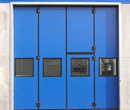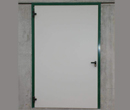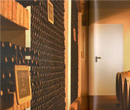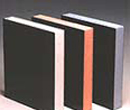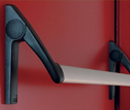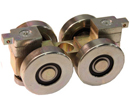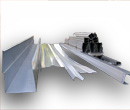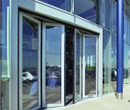Servicii » Aluminum Joinery
Characteristics of METRA profiles
We execute aluminum joinery with METRA AND PROFILCO PR 63 and RO555 profiles.
Aluminum joinery with thermic cutting made with METRA NC 150 Superthermic system, with extruded profiles in aluminum alloy EN AW 6060 (EN 573-3 and EN 755-2), physical state of furnishing UNI EN 515.
The fixed frame will have a total width of 149 mm and the assembling will be made with 90° cuttings, where there are the horizontal traverses, to guarantee the stability on the vertical mullions. The thermic cutting is obtained by inserting polyamide rods reinforced with fiberglass, 24 mm total width and 2 mm tick. The blocking will be mechanical with external rolling with the forward indentation of the aluminum plates to avoid the slidings of the profile itself. The lower and upper traverses will have double thermic insulation and the lower traverse will have the guiding system with sliding ball bearing of polyamide reinforced with fiberglass also replaceable. On the fixed lower traverse there will be orifices for the water drainage and it will be sealed at the edges with fixing glue on the proper plates.
The mobile frame will have a total width of 60 mm and the assembling will be made with 45° cuttings.
The fixing of the corner profile will be secured by square-shaped extruded aluminum plates inserted internally or externally in the leaf profile. The corner profile cutting will be sealed to guarantee the fixing. The thermic cutting is obtained by inserting polyamide rods reinforced with fiberglass, 18 mm total width and 2 mm tick. In the lower traverse of the mobile frame there will be two air vents. The fixing will be ensured by special EPDM accessories or brush accessories mounted along the perimeter of the leaf and by two smaller brushes on the central mullions of the leaves.
The central mullion will be made of two profiles united with each other by inserting extruded PVC. The movement of the leaves will be made easy with a special sliding mechanism with lifting or base. The accessories will be the original studied ones and serial products.
The protection and the superficial finishing of the profiles is made by painting them with powders in RAL colors in series like in our catalogue, QUALICOAT quality, by the following cycle:
-Pre-treating by degreasing, washing, phospho-cromating with Alodine, rinsing with demineralised water and drying with hot-air flux>
-Painting in the pressurized cabin with polyester-typed powders>
-Thermic polymerizing of the powder at a temperature between 180° and 190° for 24 minutes>
As an alternative to painting, a surface treating can be made by anodic oxidation according to QUALANOD quality trademark.
The joinery will be completed with the proper accessories made to guarantee the proper functioning.
The simple thermo-insulating windows are separated by an aluminum profile re-filled with molecular net 12-9-6 mm thick, function of the thickness of the rods with double sealing with butyl and tyokol. NB: the final cleaning of the furnished materials is not included.
Characteristics of the PROFILCO PR 63 and RO555 profiles
Our company observes the testing system ISO 9001 for the extruded profiles by the Production and the Quality Control Department of our company that, by implementing this system, tests the extruded profiles. The tests have been made with the specifications stipulated in the following norms: ELOT EN 12020-2, EN 755.02 and DIN 17615 and in the QUALICOAT for the powder painting.
The alloy EN AW 6063 (Al Mg 0.7Si) is used for the production of profiles and has the following technical characteristics:
Heat treatment: T5.
0.2% resistance test: RP0.2 = 130 Mpa (min).
Absolute resistance: Rm = 175 MPa (min).
Density: Y = 2.69 g / cm ³.
Elastic module: E = 70 000 N / mm ².
Linear expansion quotient: α = 2.34x10-6 / K
Minimum elongation: A50mm% = 6 (min).
Geometric characteristics
The tolerances of the dimensions (wall thickness and the rest), observe the specifications stipulated in EN 12020-2, e.g. if we have 55 mm, the tolerance is +/- 0.40 mm which means the dimension is between 54.60 and 55.40 mm.
According to the specifications of EN 12020-2 for a profile bar of maximum width 75 mm, the deviation is 2 mm. The curving is measured by putting the bar on a plateau with plain surface and measuring the maximum distance at any point of the length between the lower surface ant the surface of the plateau.
Bending is measured by putting a bar area of the flat plate and measuring the maximum distance from any point on the length between the bottom surface and the surface of the plateau.
According to the specifications of EN 12020-2, for a 6 m bar, the accepted deviation form the straight line is of 3 mm and is measured with the profile bar placed on the horizontal plateau so that its own mass should decrease from the deviation. The deviation from the middle of the bar should not be more than 3 mm.
The hardness of the profile is tested according to the specifications of EN ISO 6506-1.
Painting in electro-static field
The painting on the surface is visualized at a 60° angle and at 2 m distance. (The QUALICOAT specifications mention 3 m). The excessive asperity, the screws, the blow traces, the inclusions, the cracks, the dark spots, the screw holes, other orifices, the scratches must not be seen at this distance.
The Quality Control Department, with technical tools and in a well-equipped lab, makes paint thickness tests and various chemical and mechanical tests. For these tests, the specifications of QUALICOAT are observed.
The weight specified in this catalogue is the theoretical weight of the profile finished in the factory. There is a tolerance between the theoretical weight and the real one: up to +/- 6 % and the added weight due to the color is up to 3-4 %.
